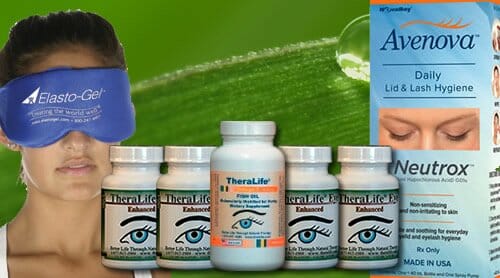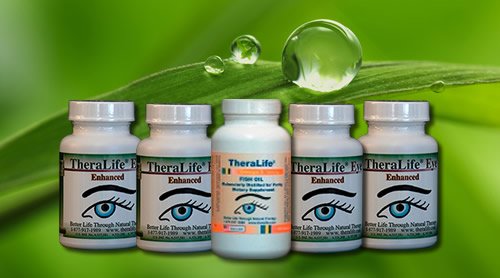Watery Eyes Relief That Works

- Stop Tear Over Production Now.
- Recover From Irritated, Sore Eyes.
- Oral Therapy from Inside Out. No More Drops
- Clinically Proven. Doctors Recommended!
Testimonial
“I have had dry eyes for many years and tried all kinds eye drops and with no results. Last year, my eyes watered so much I could not read. I started taking TheraLife Eye capsules and started to have some relief within 2 weeks…”
– S. R. United States
*Results may vary
Call and talk to a doctor if TheraLife is right for you- 1-877-917-1989 US/Canada
Take the first step to stop tear over production now!
Start with TheraLife Discounted Watery Eyes Starter Kit. 100% Money Back Guaranteed
Customer Success Story
Best Watery Eyes Treatment- TheraLife Eye
I have had dry eyes for many years and tried all kinds of eye drops and treatments from my ophthalmologist with no results. Last year, I was told I needed eyeglasses because my eyes watered so much I could not read the vision chart. I took TheraLife for only two months and started to have some relief after the first two weeks. I went for my eye test, and I was told my eyes were so much better. I don’t need eyeglasses.
TheraLife is the best watery eyes treatment that helped. I continue to take TheraLife Eye to keep watery eyes at bay.
S R. United States
*results may vary
For more customer stories on watery eyes
For independent customer reviews
Submit an inquiry form
How to stop watery eyes?
Note: Artificial tears do not work for watery eyes.
Learn how to stop watery eyes with TheraLife orally—clinically proven to work.
Theralife’s oral recovery protocol addresses all three areas of dry eyes that bring about watery eyes.
Evaporative Tears – Tear not thick enough due to blocked oil glands
Dry eyes – cause inflammation that shut off cellular function
Blepharitis – eyelid infections often associated with dry eyes that result in blocked oil glands.
Allergies – Theralife Eye capsules contain natural ingredients to relieve allergy symptoms.
TheraLife Protocol That Works
1.TheraLife® Eye Enhanced has been clinically shown to increase oil production in meibomian glands, stimulate tear secretion glands intracellularly (from within their cells) to allow you to produce the right balance, natural tears from your own eyes. TheraLife® Eye Enhanced works without washing away the valuable mucin, lipids, and protein components that lubricate the eye – unlike eye drops applied to the eye’s surface, which can strip the eyes of its healthy, natural substances.
2.TheraLife Omega 3 fish oil – molecularly distilled for purity – to provide enough oil to thicken tears.
3.Warm compress – unclog meibomian oil glands and restore tear balance.
4. Eyelid cleanser to stop blepharitis eye infection
TheraLife® Eye Enhanced works without washing away the valuable mucin, lipids, and protein components that lubricate the eye – unlike eye drops applied to the eye’s surface, which can strip the eyes of its healthy, natural substances.
What Happens if Watery Eyes Are Not Treated?
Not treating watery eyes can lead to other eye problems symptoms such as cornea scarring, loss of vision, and spreading infections that require medical attention.
Types
Problems that cause watery eyes to fall into three categories:
- Allergy – Too much tear production.
- Chronic Dry Eyes – A problem with the composition of the tears
- Poor tears drain due to blocked tear duct.
A host of other symptoms problems can lead to watery eyes. Your eye doctor will need to examine the surface of your eye and its tear system to pinpoint the origin of the issue.
Do allergies and dry eyes cause your watery eyes?
Watery eyes are a common sign of allergies, but is it also a sign of something else? Specific symptoms signal whether those watery eyes are allergies or dry eye syndrome. Your eye doctor will do an eye examination and have your history medically reviewed.
How many people have allergies?
More than 50 million people suffer from allergies every year. Allergic rhinitis also referred to as hay fever, can cause watery eyes, sneezing, itchy eyes, and a runny nose. Allergy sufferers often find that they experience seasonal allergies.
How many people have both allergies and dry eyes?
National health service indicates up to 10 percent of those who believe they may have allergies may have dry eye syndrome.
Dry Eye Syndrome or Allergies?
Eyes feeling dry are a common complaint about many people who visit their doctor. Almost 5 million Americans suffer from watery, dry eyes. Many people that suffer from dry eye syndrome believe that they have allergies. So how can a person tell the difference between dry eye syndrome and allergies? We suggest you work with your eye doctor to have your symptoms medically reviewed.
The eyes react in the same way: redness, itching, burning eyes with clear, watery discharge to any allergens.
Why do dry eyes cause watery eyes?
Dry eye disease leads to extremely watery eyes. As the body’s natural response, the eyes allow tears flow to make eyes moist and wash away foreign objects. Tears flow becomes too many tears for the tear ducts to handle – causing the tears to overflow. Over time, irritated eyes become constant.
A tear from a watery eye is called a Reflex tear, which you can not control. Reflex tears have a different consistency and quantity than the basal tears that generally coat the cornea. They do not have the balanced components that basal tears do because their purpose is to flood the eye to wash away foreign objects. Reflux tear is of poor quality.
Besides excessive tearing of the eyes and constant irritation, a dry eye disease also causes other vision problems, stinging, burning, pain, and light sensitivity.
How do tears drain?
With each blink of the eyelids, tears spread across the front surface of the eye, known as the cornea.
Tears provide lubrication, reduce the risk of eye infection, wash away foreign materials in the eye and keep the eyes’ surface smooth and clear.
Excess tears in the eyes flow into small drainage ducts in the inner corners of the eyelids called the tear duct, which drains into the back of the nose.
That is why your eye doctor suggests opening up your tear duct surgically when you have watery, dry eyes.
Sometimes, opening up the tear duct is not enough.
Other Causes of Watery Eyes
Blocked Tear Ducts.
The tear ducts are the eyes’ natural drainage system. They are the small holes in the corner of your eyes—the lacrimal glands which produce tears. The tears accumulate in the eye and overflow with tear ducts becoming blocked. Tear ducts then drain the excess tears. They are making it look like you are crying all day long.
Causes of blocked tear ducts
Several factors cause blockage to the tear ducts like aging, inflammation, infection, injury, and more.
Blocked tear ducts in infants
Blocked tear ducts are the most common cause of watery eyes for infants.
Babies, especially newborns, are susceptible to blocked tear ducts.
A pediatric ophthalmologist can help make the correct diagnosis and provide medical advice.
Common cold
Ectropion and Entropion
The eyelids serve as the eyes’ windshield. They spread the tears through the eye surface when you blink and get rid of the extra moisture and debris. Eyelids turning inward or outward can cause watery eyes.
Either ectropion or entropion can result from a blepharitis eye infection.
Eyelid Issues
Either of these two eyelid problems can trigger watery eyes.
Pinkeye
Pink eye is also called conjunctivitis with thick discharge and red eyes. Either bacterial or viral conjunctivitis can cause it. A watery eye is a common symptom of conjunctivitis.
Common Colds
Common colds are usually the leading cause of pink eye.
Allergies
Allergies are a primary reason for watery eyes. Allergens like pollen, dust, fumes, animal dander can trigger allergy symptoms. Allergies can also cause redness, swelling, and eye irritation.
Styes and chalazion
Bacteria usually cause styes. These red, painful lumps along the eyelid can also cause watery eyes. Applying a warm compress on the eye can help it heal faster.
Bell’s Palsy
This facial condition can cause facial muscles to paralyze or weaken due to nerve damage. It causes the face to droop or become stiff on the affected side. Bell’s palsy can also affect the eyes in excessive tearing, dry eye disease, or the inability to close the eye.
Sjogren’s Syndrome
Sjogren’s is an autoimmune disease that attacks moisture-producing cells, including eyes, mouth, lungs, and more. This results to dry mouth, dry eyes, and watery eyes.
Medications
Some medications can also cause watery eyes as a side effect. Among these prescription medications are chemotherapy drugs.
Environment
Weather conditions like winter, strong wind, too much sunshine, or dusty weather can also trigger the eyes to produce more tears.
Computer overuse causes dry eyes and watery eyes.
Other environmental factors like bright light, smog, air conditioning, exposure to chemicals, gases, or liquid can cause eye irritation, leading to watery eyes.
Tear chemistry: In some cases, an imbalance in the chemistry of your tears or other substances that lubricate the eye causes watery, dry eyes.
Oils that line the eyelids can be out of balance, causing problems in the formation of the tear fluid. Glands can produce too much oil or become blocked, preventing tears from reaching the drainage system and causing excessive eye-watering.
Facial nerve dysfunction:
Many nerves run through the eyes and the face. When there is injury or damage to these nerves, like in cases of facial palsy, the pumps and mechanisms that move tears through the duct system can become weak. When the pumps fail to move, excessive tears through the drainage system can accumulate in the eye and result in watery eyes.
Symptoms of Watery Eyes
Following symptoms that are typical for watery eyes include red, puffy, itchy eyes, blurring vision; eye pain; eye discharge; and eye twitching.
Diagnosis
If you have excessive watering eyes, you should consult with your eye doctor to have your eyes medically reviewed. Your eye doctor can make professional medical advice based on your tear system.
Typical Treatment
Your doctor will recommend treatment that includes: antibiotics for eye infections, eye drops for allergies, and chronic dry eyes.
These include more than dry eye-induced watery eyes. Over-the-counter remedies:
- Eye Drops. What your eye doctors are most likely to prescribe. Artificial tears can help wash away any foreign object like dust that may be causing your eyes to overwater. However, if your watery eye is due to too many tears, eye drops will only worsen the matter.
- Prescription medications and over-the-counter allergy medicines to relieve allergies that cause watery eyes. Learn more about the allergy and watery eyes.
- Treatment for irritation. If bacterial infections and conjunctivitis cause teary eyes, the doctor may wait before antibiotics. For allergic conjunctivitis, use an antihistamine.
- Treatment for Trichiasis: an inward-growing eyelash or some foreign object lodged in the eye. The doctor will remove it in the affected eye.
- Treatment for ectropion: The eyelid turns outward. Surgery may be necessary to tighten the tendon that holds the outer eyelid in place in the affected eye.
- Treatment for blocked tear duct: Surgical procedure may be necessary to create a new channel for the tears to bypass the blocked tear duct. If the drainage channels are narrow, the doctor may use a probe to make them wider. The surgery will be the best treatment when the canaliculi are entirely clogged.
- Pediatric Ophthalmology – watery eyes in babies. Take baby to a pediatric ophthalmology department at most hospitals to be examined by a pediatric ophthalmologist. Most of the time, this condition resolves itself on its own within a few weeks.
- Do not wear eye makeup to prevent eye infections.
Risk factors.
Watery eyes can develop for many reasons. Pay attention to :
- Age. Dry eyes are a part of the natural aging process. The majority of people over age 65 experience vision changes and dry eyes symptoms.
- Gender. Women tend to have more dry eyes due to hormonal changes caused by pregnancy, the use of oral contraceptives, and menopause.
- Medications. Antihistamines, decongestants, blood pressure medications, and antidepressants decrease tear production.
- Medical conditions- Underlying causes from Autoimmune Diseases – People with immune system abnormalities such as Sjogren’s Syndrome, rheumatoid arthritis, diabetes, and thyroid problems are more likely to have dry eye symptoms.
- Blepharitis Inflammation of the eyelids results in sticky crusty discharges.
- Inward and outward growth of eyelashes induces watery eyes.
- Environmental conditions. Smoke, wind, and dry climates can increase tear evaporation resulting in dry eye symptoms: failure to blink regularly and everyday computer user issues contributing to dry eyes.
- Contact Lenses and LASIK – Long-term use of contact lenses can be a factor in developing dry eyes. Refractive eye surgeries, such as LASIK, can decrease tear production and contribute to dry eyes.
Home remedies for watery eyes resolve.
Here are some steps you can take to prevent dry, itchy, eye irritations:
- When using computers or watching TV, and reading – blink often. Take periodic breaks to rest your eyes and to avoid eye strain.
- Use a humidifier in your home or work.
- Wear wraparound sunglasses to reduce exposure to sun and wind.
- Drink lots of water to produce plenty of tears. A recommendation is 6-8 glasses per day.
- Use warm compresses regularly to help tears drain properly. A warm washcloth does not work.



Testimonial
"I am 6 months post LASIK. I was diagnosed with dry eyes and MGD. My eyes are red, inflamed with mucus. I can not begin to tell you how much Theralife has made a difference for my eyes! I'm still currently using 3-4 capsules twice daily, along with fish oil, warm compresses and daily eye hygiene with lid scrubs. My eyes have been feeling great! Thank you so much for caring. " Sincerely, Elise, , United States *Results may vary
TheraLife Eye Enhanced and Fish Oil Bundle – 3 Month Supply
TheraLife is unique: It can actually stop tear over-production (naturally!) and end your watery dry eyes! No other product on the market can stop tear over-production.
It takes 3 months to stop tear over-production using TheraLife Eye Enhanced. Get started now! Dr. Yang specifically recommends this Eye Enhanced and Fish Oil 3 Month Supply Bundle for watery dry eye sufferers because it contains everything you need to achieve relief.
A 3-month supply is usually the minimum required to achieve significant, lasting results. Buy the bundle and save!

$450 $410 ( Save $40. or 10% )
[su_shopsite price=”$374.55, NOW DISCOUNTED TO: $324.55. You save $50!” add_to_cart_link=”https://www.theralife.com/cgi-theralife/sb/order.cgi?storeid=*16d4c5d9ca8140121747ab5ff2&dbname=products&guid=467446c6-779b-11e2-933c-00259064f23a&function=add”]
- 12 bottles of TheraLife® Eye Enhanced
- 3 bottles of TheraLife® Omega-3 Fish Oil
Buy Now



